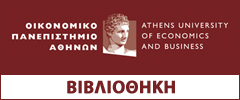| Collections : |
|---|
| Title : | Statistical learning approaches and applications in portfolio selection |
|---|
| Alternative Title : | Προσεγγίσεις στατιστικής μάθησης και εφαρμογές στην επιλογή χαρτοφυλακίου |
|---|
| Creator : | Παπασπύρου, Δημήτριος-Σταύρος Papaspyrou, Dimitrios-Stavros |
|---|
| Contributor : | Papayiannis, Georgios (Επιβλέπων καθηγητής) Yannacopoulos, Athanasios (Εξεταστής) Zimpidis, Alexandros (Εξεταστής) Athens University of Economics and Business, Department of Statistics (Degree granting institution) |
|---|
| Type : | Text |
|---|
| Extent : | 64p. |
|---|
| Language : | en |
|---|
| Identifier : | https://www.pyxida.aueb.gr/index.php?op=view_object&object_id=11527 |
|---|
| Abstract : | Η παρούσα μελέτη συνδυάζει βασικές και ενημερωμένες θεωρίες από τη Μηχανική Μάθηση και την επιλογή χαρτοφυλακίου, προκειμένου να εξετάσει την εφαρμογή τεχνικών ομαδοποίησης σε χρηματοοικονομικά δεδομένα. Υλοποιούμε τρεις προσεγγίσεις στατιστικής μάθησης K-means, Gaussian mixture models and Spectral clustering σε ένα σύνολο δεδομένων που αποτελείται από τις 50 κορυφαίες εταιρείες του δείκτη S&P 500 για μία περίοδο έξι ετών (2014-2019). Τα διαχειριζόμαστε σε ένα στατικό πλαίσιο δεδομένων και, για το λόγο αυτό, εξετάζουμε το έργο αυτό βάσει τεσσάρων στατιστικών χαρακτηριστικών που εξήχθησαν: τη μέση απόδοση, την μεταβλητότητα, τον δείκτη ασυμμετρίας και την κυρτότητα. Προτείνουμε μία εναλλακτική μέθοδο για την τυπική προσέγγιση του Markowitz στην επιλογή χαρτοφυλακίου. Η προτεινόμενη μέθοδος συνδυάζει αποτελεσματικές τεχνικές ομαδοποίησης για τον διαχωρισμό των δεδομένων σε ομοιογενείς ομάδες και το τυπικό μοντέλο Markowitz εντός και μεταξύ των ομάδων. Κατασκευάζουμε βέλτιστα χαρτοφυλάκια βασισμένα στο τυπικό μοντέλο Markowitz για τα μη ομαδοποιημένα δεδομένα και στο two-step Markowitz για τα δεδομένα με βάση την ομαδοποίηση. Η απόδοση των χαρτοφυλακίων αξιολογείται μέσω κατάλληλων μέτρων κινδύνου και απόδοσης, όπως η Αξία σε Κίνδυνο (VaR) και ο Δείκτης Sharpe. Μέσα από το αριθμητικό πείραμα, φαίνεται ότι ακολουθώντας αυτήν τη στρατηγική μπορούμε να κατασκευάσουμε χαρτοφυλάκια που υπερέχουν του τυπικού χαρτοφυλακίου Markowitz. This study combines basic and updated theories from machine learning and portfolio selection in order to examine the application of clustering techniques to financial data. We implement three statistical learning approaches—K-means, Gaussian mixture models and spectral clustering—on a dataset comprised of the top 50 companies of the S&P 500 over a six-year period (2014-2019). We treat them in a static data framework and for that reason, we examine this project based on four statistical features we extracted from them: the mean return, the volatility, the asymmetry index(skewness) and the kurtosis. We propose an alternative method to the standard Markowitz approach to perform portfolio selection. The proposed approach combines effective unsupervised learning techniques (clustering) to distinguish data to homogeneous groups and the standard Markowitz model within and across the groups. We construct optimal portfolios based on the standard Markowitz for the unclustered data and the two-step Markowitz for the cluster-based data. The performance of the portfolios is evaluated through appropriate risk and portfolio metrics like Value-at-Risk (VaR) and the Sharpe Ratio. Through the numerical experiment, it seems that following this strategy, we may be able to construct dominating portfolios to the standard Markowitz portfolio. |
|---|
| Subject : | Μηχανική μάθηση Επιλογή χαρτοφυλακίου Τεχνικές ομαδοποίησης Χρηματοοικονομικά δεδομένα Αξία σε κίνδυνο Machine learning (ML) Portfolio selection Clustering techniques Financial data Value at Risk (VaR) Markowitz model |
|---|
| Date Issued : | 30-09-2024 |
|---|
| Date Submitted : | 03-10-2024 |
|---|
| Date Accepted : | 03-10-2024 |
|---|
| Licence : |  |
|---|






 Copyright © 2013 Library AUEB. All rights reserved.
Copyright © 2013 Library AUEB. All rights reserved.